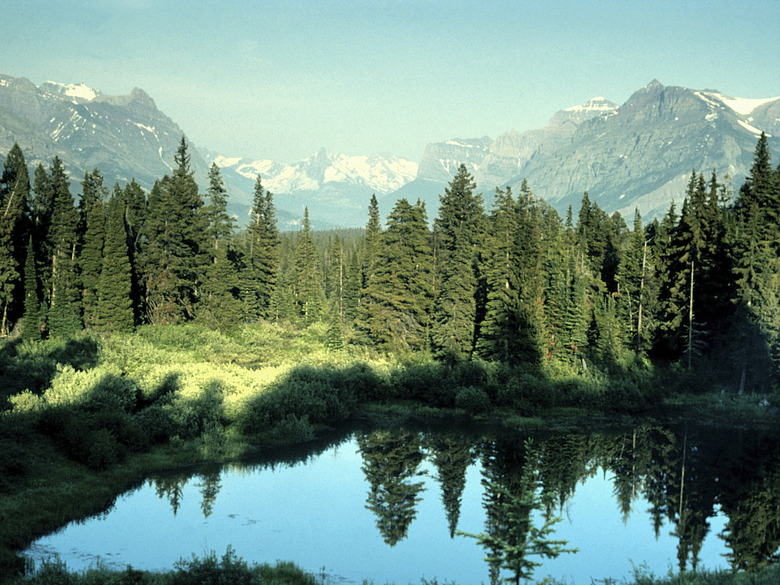What Type Of Plants & Animals Live In Lakes?
What lives in a lake? The Earth is a watery planet, and lakes – saltwater and freshwater, natural and man-made – can be found all over its surface. Almost two-thirds of the world is covered in water, and while most of this is ocean, the number of lakes is considerable. Washington State alone has more than 7,800 lakes; the state of Minnesota has more than 12,000 of them. Lake ecosystems are home to many varieties of plant and animal life, including familiar aquatic species that can be found in other similar habitats, such as ponds and rivers.
Lake Plants
Lake Plants
Aquatic plants like cattails and pickerelweed often live in or around lakes. There are several species of cattails – also known as bulrushes – famous for their fuzzy, elongated exteriors. Pickerelweed is less well-known. It is an aquatic plant which lives in or around streams, ponds and lakes.
Pickerelweed grows to three or four feet tall, but one or two feet of the plant's length will remain underwater while the rest grows into the sun. Pickerelweed is distinctive for its bright purple flowers, which grow on large protruding spikes. The flowers are quite small and grow in clusters. Pickerelweed flowers begin to bloom in July and keep going until November.
Various wild animals can eat pickerelweed leaves, including deer, geese, ducks and muskrats. The plants can also provide a protective cover for fish, reptiles, birds and amphibians.
Fish That Live in Lakes
Fish That Live in Lakes
Too many fish varieties live in lakes to be listed here. Lake fish species can include trout, salmon, bass, catfish and perch. The northern pike is a common freshwater fish found in lakes all over the world. In the United States, major northern pike populations live in the Great Lakes Basin, New England, Alaska, Arizona and even northern New Mexico.
According to the Minnesota Department of Natural Resources, pikes live in almost all of the state's streams and lakes. Pikes are meat-eaters and are a favorite of fishermen because they are so voracious that they will easily take the bait of a lure. Most pikes weight around two or three pounds, but trophy pikes have been caught weighing more than 20 pounds.
Water Snakes
Water Snakes
Several kinds of snakes live near lakes. The most feared is the poisonous water moccasin, also known as a cottonmouth. Water moccasins are the only poisonous aquatic snakes in North America, and are a type of pit viper.
The Lake Erie water snake should not be confused with the highly deadly water moccasin. Though the Lake Erie water snake will defend itself by biting if threatened, it is nowhere near as dangerous. Adults can grow to be between 18 and 42 inches long. It typically has a gray coloring with a white underside, although it can also be green or brown.
The Lake Erie water snake does not actually live in the lake but rather near the edges of the water. Its favorite sunning spots are rocks and other handy surfaces on the shore. Lake Erie water snakes can and will swim, however. These snakes can swim both across the surface of the water as well as dive to the bottom of the lake. Lake Erie water snakes usually eat fish and may interbreed with the Northern water snake.
Other Lake Animals and Insects
Other Lake Animals and Insects
Besides fish and snakes, there are many other types of animals that live in and around the freshwater habitat of a lake. These include mammals like mink, beaver and otter, and birds like heron, geese and ducks.
Insect life in and near lakes includes water bugs, dragonflies and water beetles. Water striders appear to walk on the surface of the water with their long legs, and water boatmen have oar-shaped structures on their back legs that help them swim in lakes, ponds and rivers. Insects are prey for many of the fish and mammals that live in lakes.
References
- Minnesota Department of Natural Resources: Northern Pike
- Ohio Public Library Information Network: Water Snake, Lake Erie
- Lady Bird Johnson Wildflower Center: Pontederia cordata (Pickerelweed)
- Nature Education: Ponds and Lakes: A Journey Through the Life Aquatic
- Outdoor Alabama: Cottonmouth
- Encyclopedia of Alabama: Freshwater Invertebrates
Cite This Article
MLA
Walker, Amber D.. "What Type Of Plants & Animals Live In Lakes?" sciencing.com, https://www.sciencing.com/what-type-of-plants-animals-live-in-lakes-12394715/. 30 September 2021.
APA
Walker, Amber D.. (2021, September 30). What Type Of Plants & Animals Live In Lakes?. sciencing.com. Retrieved from https://www.sciencing.com/what-type-of-plants-animals-live-in-lakes-12394715/
Chicago
Walker, Amber D.. What Type Of Plants & Animals Live In Lakes? last modified March 24, 2022. https://www.sciencing.com/what-type-of-plants-animals-live-in-lakes-12394715/
